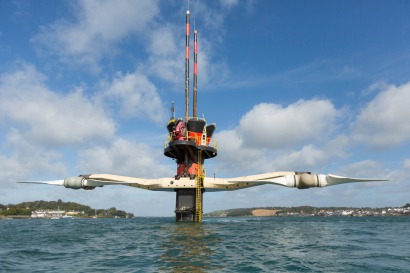
The UK Energy and Climate Change Secretary, Ed Davey, has praised Siemens for its investment in innovative marine technologies while visiting a new testing and assembly facility in Bristol.
The 25,000 square feet facility will play an important role in the development of next-generation drive trains used in SeaGen – the world’s first and largest tidal turbine developed by Bristol company Marine Current Turbines (MCT), which is now a fully-owned Siemens business. It will be the first of its kind in the UK and will be used by the MCT team to assemble and test the first drive trains with full testing conducted at Narec in Northumberland. The Bristol facility will be used for series production of the systems to be deployed on multi-turbine arrays in 2016, such as those in the Skerries and Kyle Rhea, and other arrays beyond that.
“Siemens' new testing and assembly facility for tidal turbines in Bristol is a real boost for the South West and for the UK's world leading marine energy industry” Mr Davey said. “Wave and tidal power has an important part to play in our low carbon energy mix, with the potential to sustain up to 19,000 jobs in this sector alone by 2035.”
Mr Davey added that the coalition government has announced levels of support for wave and tidal power generation that are far higher than any other low carbon technology.
“I want to see the sector take the final steps to get these exciting technologies to market” he continued, “so it's great to see Siemens ramping up their involvement in marine power, I wish the new centre every success.”
In February MCT was announced as a successful recipient of a £10 million Marine Energy Demonstration (MEAD) grant from the Department of Energy & Climate Change (DECC). The award in association with consent for the 10MW Skerries Tidal Array in North Wales, to be developed by MCT, has helped to underpin Siemens investment in this technology. Achim Wörner, CEO of Siemens Energy Hydro and Ocean Unit, commented that the UK is a key market for the company in developing wave and tidal technology, given that the country has the right combination of coastal and tidal factors along with market development and a favourable investment environment.
“Our proven SeaGen technology operating successfully in Strangford Lough in Northern Ireland since 2008 is capable of full-scale commercialisation and wider deployment” Mr Wörner added. “Investment in the new assembly and testing facility in Bristol will enable us to make this step to develop next-generation tidal technology as well as larger arrays. Further commercialisation will have a positive effect on the supply chain, job creation and the generation of eco-friendly electricity for the UK.”
Tidal turbines are now an important part of Siemens environmental portfolio which earned the company around €33 billion in revenue during the fiscal year 2012.
Further information:

